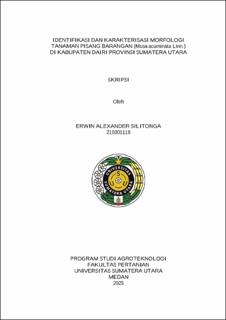Identifikasi dan Karakterisasi Morfologi Tanaman Pisang Barangan (Musa acuminata Linn.) di Kabupaten Dairi Provinsi Sumatera Utara
Identification and Morphological Characterization of Banana Barangan (Musa acuminata Linn.) Plants in Dairi Regency North Sumatra Province

Date
2025Author
Silitonga, Erwin Alexander
Advisor(s)
Damanik, Revandy Iskandar Muda
Metadata
Show full item recordAbstract
Barangan is a banana that is very popular with people in Sumatra as a table fruit because it has a delicious and sweet taste. Characterization of barangan morphology is needed as a support for the assembly of superior varieties, through characterization can be known typical traits or characteristics of a type of barangan and to evaluate kinship relationships. This study aims to identify morphological characters of barangan (Musa acuminata Linn.) in Sidikalang District, Berampu District and Laeparira District in Dairi Regency. This research was conducted from February 2025 to April 2025 using descriptive survey method based on IPGRI (International Plant Genetic Resources Institute) banana descriptor guidebook with snowball sampling technique. Barangan has 3 types namely red barangan, yellow barangan and white barangan, based on research generally in Dairi district has barangan with red barangan type. The results showed that in Dairi Regency 24 genotypes of barangan were found. The results of the morphological characteristics of barangan found are the state of the leaves (upright and medium), the color of the pseudo-stem (yellow green, red green, pink green and pink), the color of the leaf surface (dark green, green and yellow green), the shape of the heart (like a top, forming a knife, medium and forming an egg square), the color of the outer surface of the bractea (pink, purple pink, purple, brown purple, blue and pink blue), the color of the ripe fruit skin (yellow, bright yellow and green yellow), the color of the ripe fruit flesh (yellow, beige, pink beige and pink white). The closest kinship or lowest dissimilarity value is found in sample A2B1C2 with A3B1C2 which is 4.007 and the farthest kinship or highest dissimilarity value is found in sample A1B1C1 with A3B2C1 which is 73.080.
Collections
- Undergraduate Theses [3567]
